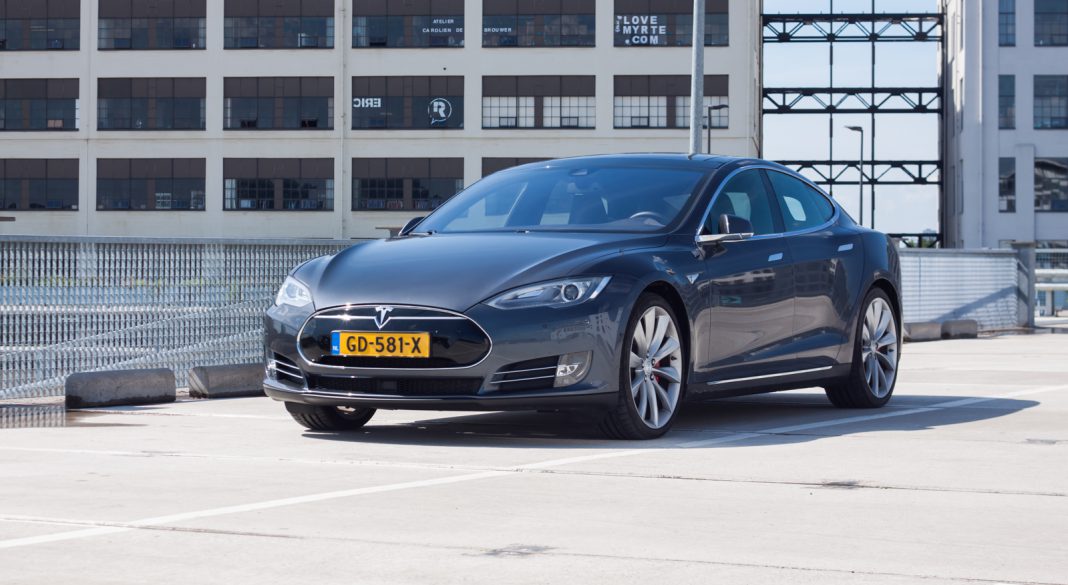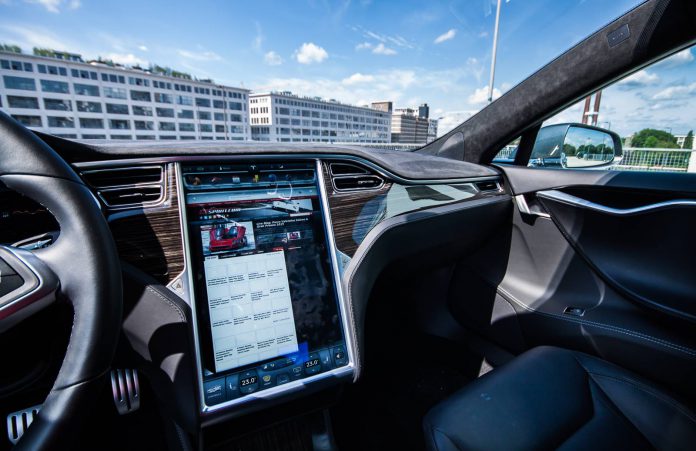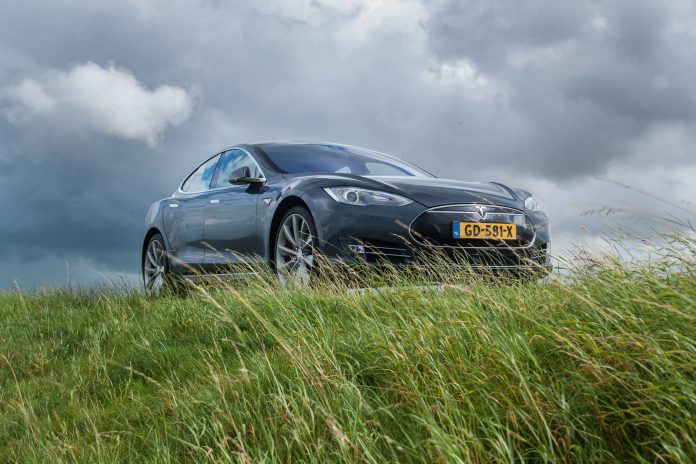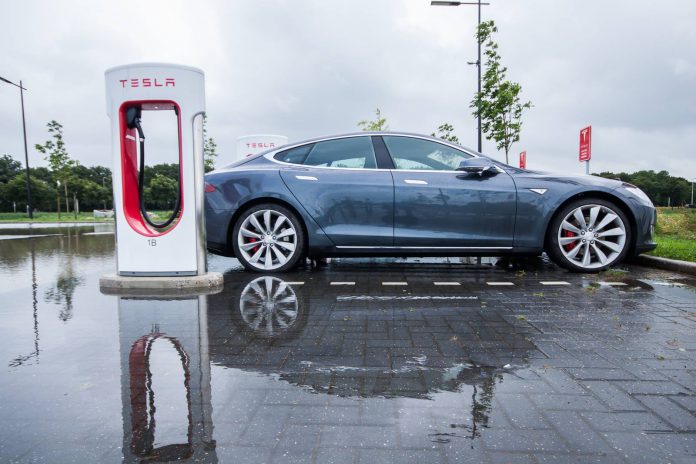If you had to mention ten cars that stirred up the automotive world the last ten years, the Tesla Model S would be among the top candidates. Lately the American born electric sedan has been conquering the luxury car segment, and not without success. It became market leader in the electrical vehicle market in no time, leaving other manufacturers on the sideline. Its performance figures are just as impressive, the Model S P85D rushes to a 100 km/h in just 3.2 seconds. The latter alone, is already more than enough reason for GTspirit to take it for a spin and see what all the fuss is about.
We had the opportunity to test the Tesla Model S P85D for five days, enough time to get familiar with the Tesla and to find out what it is like to live with one. Our particular Model S P85D was well specced and came with virtually every optional extra one could wish for.
For starters, It features a 85 kWh battery and dual engine AWD system delivering a total of 691hp. The most powerful engine is located in the back, capable of delivering 470hp. The second engine – located in the front of the car – delivers an additional 221hp. The dual engine setup makes for a unique drivetrain, where the front engine exclusively powers the front wheels and the rear engine powers the rear wheels.
At a first glimpse the Model S looks quite slick, we dare to say it is one of the best looking and coolest American cars on the market today. The large 21 inch wheels contribute to that as well, which you can easily get away with on a car of this size. Before we get in, we shouldn’t forget to mention the shiny door handles that pop out of the door once you and your key get in range of the car. The door handles are a nifty touch that add to the feeling of luxury, leaving you all the more curious to find out what’s inside.
Inside, it’s the large 17-inch center screen that intrigued us the most. It’s literally and figuratively the center point of the car and its interior. It’s slightly turned towards the driver for optimal vision. Before we get into the technical details of the mid-console, let’s take a detailed look at the used materials. This model is equipped with full leather ‘Black next generation seats’ and the dashboard is trimmed with a ‘Obeche wood gloss décor’. The headliner is finished with black alcantara and this particular model features an all-glass panoramic roof. The inside of the car is exactly what you’d expect it to be in terms of space once you have seen the outside proportions. Thanks to the all-glass panoramic sunroof, the car is very light on the inside as well.
This car breathes comfort and space, leaving more than enough room for three adult rear seat passengers. In terms of comfort there is nothing really to complain about in the driver’s seat either, unless you fancy seat air-conditioning. The seats in general are very comfortable and ideal for long highway cruises, while at the same time they provide excellent support for the more adventurous drivers.
Arriving at the trunk of the car – which opens automatically by pushing twice on the back of the key – you are left to wonder where they hid the rear engine. The boot offers 714 liters of luggage space and under the front bonnet of the car there is an additional 150 liters of storage capacity. The combined 864 liters of luggage space are 300 liters more than its nearest competitor in the luxury segment – the Audi A6 – leaving other rivals such as the BMW 5-Series, Mercedes-Benz E-Class and Jaguar XF even further behind.
At last it’s time to assess the large iPad like screen that controls everything in the car. The first thing we notice when sifting through the menus is that the touchscreen is very responsive. Switching between the sat nav and driver settings has never been this quick. The massive screen also gives you the opportunity to control two different menus at the same time. At the top of the screen we find the following submenus to choose from: media, navigation, energy, internet, camera and phone.
The navigation is based on Google maps and is easy to control using similar touch gestures as you would on an Ipad. Besides the overview map on the big screen, there is also a first person view located left of the speedometer. The energy menu keeps you apprised of your recent driving habits. Many quick accelerations and fast driving logically lead to a reduced range. If you were to opt for the connectivity package, it’s also possible to browse the internet in the Tesla as it will be connected to the 3G/LTE network instantly.
Finally there is an HD camera installed at the rear, making sure you can’t go wrong parking this car. Fun feature: it works at any time. Just make sure you don’t suffer from motion sickness or anything alike when you choose to see what’s behind you on the motorway.
Arriving at the driver settings, there is a range of options to choose from. Let’s start at the beginning, where it’s possible to create your own driver profile. The car remembers your seating position, mirror positions and overall general settings. The fully automatic sunroof can be swiped open like a smartphone and isn’t bound to fixed positions; you can open it on a range from 1 to a 100 percent.
The suspension settings are easy to control as well; just by a single touch you can higher or lower the air suspension of the Tesla to your liking. This is especially useful when you for example have a raised driveway and you want to make sure that you won’t accidentally scrape your front bumper when entering it. On the other end you might feel inclined to lower the suspension when taking some corners or when driving at higher speeds on the motorway, thus improving aerodynamics and conserving energy. This can be automated as well, letting you choose from which speed it should automatically lower its suspension. There’s even more to Tesla’s genius suspension setup: the car remembers geographically where you have changed the suspension settings while driving, making sure it will adjust them automatically when getting in range of that specific location.
The steering settings let you choose between three different modes: standard, comfort and sport. The sport setting is by far the most stiff steering setup you can choose from and good to use if you were to try out insane mode. Acceleration can be set to sport or insane mode, where insane mode blasts you to a 100 in just a little over three seconds.
Like most electric cars and plug-in hybrids the Model S also features regenerative braking. It’s quite literal in that sense, letting go of the throttle feels like stepping on the brake the first time you try it. Luckily the brake lights do turn on once you take your foot off the throttle; this might look a bit spastic on the motorway for example, but it would completely be deemed unsafe if the lights weren’t to turn on when letting go of the gas pedal. Yes, it loses pace that fast in order to get the most out of the regenerative braking feature – in other electric and hybrid cars like the E-Golf you can actually switch this off.
Finally there is the option ‘range mode’. Tesla explains it as it will distribute the torque equally over all four wheels in order to conserve energy, as well as regulate the energy consumption in all other features of the car. This is recommended when you want to get the most out of your battery in terms of range and we can see why. The differences in it being enabled and not enabled are quite significant.
The cold weather menu let’s you control the seat heating of every seat in the car individually. Furthermore there is heating of both the steering wheel and windscreen at the driver’s disposal. Next is the display menu, that let’s you control the brightness of the screen as well as day or night mode. Always at the bottom are the lighting settings and the doors and locks settings. If you forgot the key combinations, which we could totally understand, there is always a way to open for example the trunk or the charge port using the menu on the screen.
Driving Experience
Getting behind the wheel of the Tesla Model S P85D, the first thing on our list was trying out insane mode. A simple red light should do the trick. Putting your foot down with insane mode enabled for the first time makes you immediately realize why Tesla called it insane. The throttle response is by all means unprecedented and the insane amount of torque – over 900 n.m. – makes you kickback into your seat like you are launching a fighter jet.
No lose of traction either, due to the all wheel drive and dual engine setup. This makes accelerating from zero in this car all the more impressive. Add to that, that it’s not shifting through gears either. It won’t stop pulling until you are well over 100 km/h. Having experienced insane mode, it’s no surprise why this car has been named the ‘supercar slayer’ online. You have to bring something really special to the red light, to be able to beat this electrical beast of a car. We’re talking proper supercar league, anything else you’ll see disappearing in your rear view mirror accompanied by nothing more than a whoosh.
Talking about the sound it’s producing, it really is nothing more than just an electrical whirr when accelerating and of course the tire noise. It’s amazingly silent in the cabin and if the noise from the tires annoys you at some point, it’s nothing the surround sound audio can’t take care of. This specific model as tested, was equipped with the ultra high fidelity sound package. Ideal for standard highway cruises, when the noise from the tires tends to get a bit louder. Driving on country roads and through villages, the cabin silence is even more noticeable. Downside of all this silence is of course other traffic – mainly bicycles – not hearing the car approach.
The Tesla Model S P85D is very well capable of doing 250 kilometers an hour on the autobahn, but what does this mean for the range? This brings us to the practicality and every day usability of the Tesla Model S. Of course, fast accelerations and fast driving on the motorway will have a vast negative impact on the car’s range. We found the ideal speed to get somewhat near the projected 400 kilometer range claimed by Tesla lies around a 110 kilometers an hour.
For reference, the best we have done is around 340 kilometers on a fully charged battery. The Tesla Model S P85D has adaptive cruise control, automatically braking and accelerating to keep a safe distance between you and the car ahead of you. But the Tesla cruise control, as with all other cruise control systems has a negative effect on the range. Especially in an electric car like the Tesla Model S this is a large inconvenience.
The hardware is already there and it takes just a software update – which is sent to all worldwide Tesla cars at the same time – to have a new feature installed on the car. During our few days with the Tesla, a software update was automatically installed providing us with blind spot detection. It’s quite amazing when you think about it. If there’s anything really that is currently missing and would be of added value, it’s a heads up display. The large screen can be quite distracting from time to time and when using insane mode, the last thing you want to do is take your eyes of the road to see what your current speed is.
You have probably heard of Tesla’s supercharger stations. Those are the place to go to when you are in need of a quick and free charge. Ideally, a supercharger is the place where you always want to charge your Tesla. Tesla claims it can charge the battery of the Tesla in just half an hour. Well, this is not quite the case with the 85 kWh battery featured in the Model S P85D. To be fair, the charging time really depends on many factors, as we have found out ourselves.
In the Netherlands, and probably everywhere else, the supercharger stations comprise of eight charging docks that are numbered as follows: 1A, 1B, 2A, 2B, etc. Apparently, the letters of every number share the same circuit. Meaning, that when someone is charging at 4A, charging dock 4B is probably not going to give you the desired power output in order to be ready in half an hour. So preferably always take an unused number if possible, unless you like being stuck at parking lots and finding fast food a treat.
The superchargers are usually conveniently placed near all the amenities you need and if that isn’t enough for you, there is always the social aspect of owning a Tesla. Everyone at a supercharger has something in common and we have noticed they love to talk about it. Charging isn’t as useless and time consuming as you may think. That is, when you are using one of the superchargers of course. The downside is that the supercharger coverage is not as dense as you would want it to be.
As we understood from talking to a Tesla employee, all the superchargers in Europe are strategically placed along main highway corridors so it’s possible for Tesla owners to for example drive from London to Northern Norway. While it’s great that such a possibility is there, the majority of Tesla owners don’t need to travel that far and will benefit more from a supercharger closer to home.
To put things into perspective, a public charging pole in the Netherlands will allow you to approximately take around 16 amperes and if you’re lucky that number goes up to 32. If your battery is near empty, it will take a good nine to ten hours for it to be fully charged. The Tesla supercharger gave us 320 amps at its peak, which makes you feel spoiled once you have to hook up your Tesla to anything else.
For the sake of comparison, we decided to give Dutch startup Fastned a try. Their noble initiative to put electric charging stations throughout the whole country is working and they cover pretty much all of the Netherlands. While it’s probably ideal for a plug-in hybrid with a relatively small battery, it’s a whole other story for the Tesla. Waiting for 65 minutes to find out that it just charged 125 kilometers is quite disappointing to say the least. In addition to that, it sets you back a good €20.
At the price of approximately €0,83 per kW, charging with Fastned doesn’t come cheap. Simple math tells us that charging to almost a full battery – remember, that’s less than 400 kilometers range – costs you well over €60. Put that next to any of today’s petrol cars and it makes you rethink the running costs.
To be fair, in reality the moments that you are dependent on charging stations like the ones from Fastned should be scarce. And the Model S P85D is probably not on top of your list when considering a Tesla, especially when efficiency and environmental motives play a large role. In that case, you are probably best off with a regular Models S.
Especially in Norway and the Netherlands they are popular because of the zero emissions subsidies handed out by the government which reduce running costs and depreciation to a fraction of what they would be without these subsidies. This car is absolutely perfect for your daily commute. This is what the car is made for at this current point and it really appeals to people with a certain lifestyle.
It is really unthinkable not to see one Tesla Model S driving by when you are around Amsterdam, how different that was just a few years ago. Despite the fact that the Tesla Model S is gaining popularity more and more, the P85D was still quite the eye catcher on the motorways. Not just on the motorways, also at the superchargers it was a subject of conversation for other Tesla owners.
If you are leasing a Tesla Model S, the P85D is probably not the most viable option. It makes it all the more rare and if you’re wondering what physically makes it a P85D, it’s the subtle carbon fiber back spoiler that gives it away.
To conclude, leaving the practicality debate for what it is, the Tesla Model S P85D is a car that truly intrigued us from the first moment we got behind the wheel. This car is all about the combination of comfort and performance, and Tesla Motors has nailed it. It’s tremendous fun to drive and if you are all about performance and a cool alternative to other limousines, the Tesla Model S P85D should top your shopping list.
It handles amazingly well and if you leave the performance for what it is, it is a very comfortable car to drive as well. All things considered, this is all the more impressive for a car manufacturer with such little automotive history!












































































